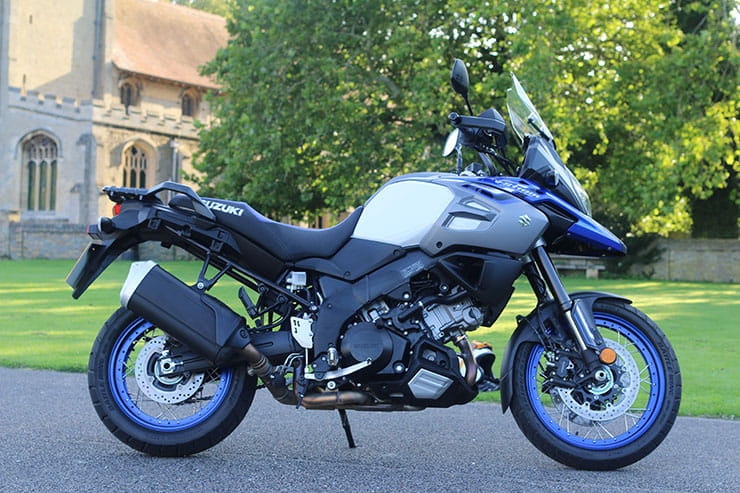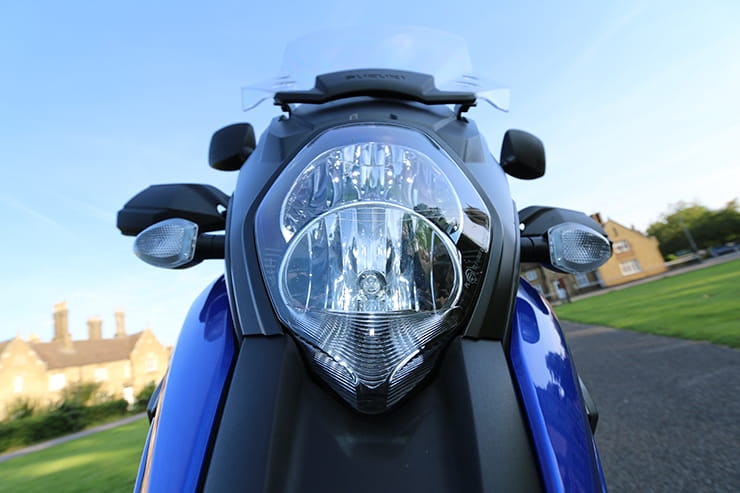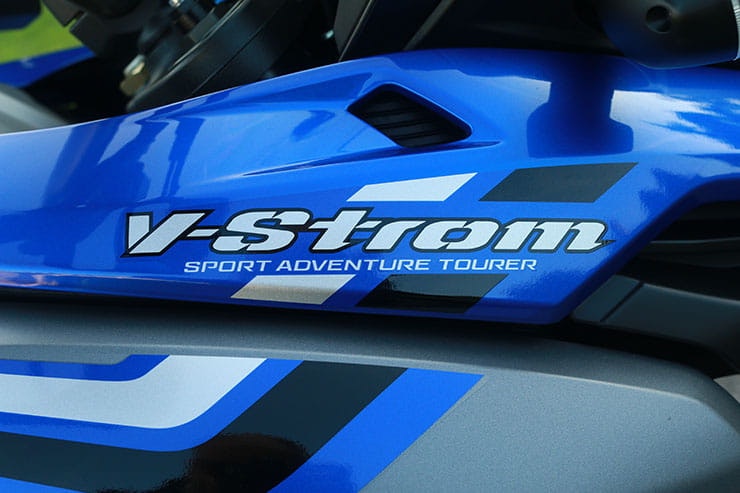Suzuki V-Strom 1000 (2019) - Review | The UK’s most underrated motorcycle?
By Steve Rose
BikeSocial Publisher
28.08.2019
Some bikes sneak up on your affections and others whack you full-on in the chops. Suzuki’s brilliant V-Strom 1000 is one of the former. Jumping aboard after two weeks on a V-Strom 650, my first impression was how similar they were. Except the bigger bike made more power (obviously), had a lot more speed for the same revs (ditto), much, much better brakes and suspension that was set more soft than the 650 and not quite as controlled charging into the many roundabouts on the Milton Keynes ring road where Suzuki GB is based. Half an hour later, I was wafting through Bedfordshire’s B-roads, enjoying the gentle ride. It was only when I looked down at the speedo that it became apparent just how good this package is.
Everyone who rode Suzuki’s V-Strom 1000 liked it. Not all adventure bikes have to be huge, shouty, ten-storey behemoths. Suzuki’s road-focussed V-Strom is simply one of those machines that does everything well. And, while the list price is competitive with the, er, competition, once you see what dealers are selling it for the case for buying a V-Strom becomes an awful lot stronger.
2019 Suzuki DL1000 V-Strom power and torque
99bhp and 75lb-ft won’t steal the headlines from the other manufacturer’s flagship adventure tourers. But the V-Strom isn’t playing on the same pitch as a KTM 1290, BMW 1250 or Ducati 1260. Measured against Honda’s CRF1000, BMW’s 850 twin and Kawasaki’s Versys the 1037cc Suzuki keeps up. More than that, this well-developed (they’ve been refining it since 1997 – only three years less than BMW’s four-valve Boxer engine) V-twin motor is a pleasure to use. Suzuki’s ‘low rpm assist’ system helps smooth out the worst of the v-twin grumbles around town, there’s enough midrange to make confident overtakes without waking-up the traction-control system and enough top-end too to keep the power coming long after peak torque (which happens at just 4000rpm).
In the 22 years since we first met this engine, it’s gained 40cc, an exhaust powervalve and lost 20bhp.
2019 SuzukiDL1000 V-Strom engine, performance and fuel consumption
A couple of years back I revisited the fire breathing legend that is Suzuki’s TL1000s. And now we are all used to bikes making fifty per cent more power, it felt tame, sane and slightly disappointing. Strangely, the TL’s V-Strom descendent feels strong, flexible and absolutely lovely, despite making 20bhp less. It’s one of those engines that you can just leave in third or fourth gear and cover 80 per cent of your miles without bothering your left foot or clutch fingers. In time, the low-rpm-assist swaps from being a gimmick into a genuinely useful tool (especially when filtering) and the ‘strong-enough-for easy-overtaking-but-not-overpowering’ top-end makes motorway cruising relaxing too.
The only slight disappointment is that the general improvements in motorcycle mpg figures haven’t made it into the big V-Strom’s performance in the same way they benefited the 650 version. Gentle riding and motorway cruising could see 45-50mpg, but typically consumption was in the high 30s-low 40s mpg, which is considerably less than the KTM 1290 Super Duke GT (for example) that I’ve been running this summer that goes a lot quicker and averages 50mpg with ease.
Honda’s CRF1000 Africa twin offers similar performance numbers to the Suzuki but feels completely different in use. Not as smooth or torquey, but you’ll get an additional 5mpg from the Honda in regular use. KTM’s 1050/1090 engine would also be an obvious competitor if you’re buying used. The performance is very similar but the KTM feels a little ‘raspier’ and more aggressive than the silky-smooth V-Strom.
Alloy frame started life in the SV1000 sports bike. Replaceable plastic frame guards protect against damage from chunky adventure boots
2019 Suzuki DL1000 V-Strom chassis and handling
The V-Strom’s last major update in 2014 brought revised styling but no significant changes to the alloy beam chassis that’s been present since 2002 and was essentially the same as the SV1000 roadster. That’s no bad thing – it’s a good chassis and the 2014 upgrade significantly improved the V-Strom’s suspension and brakes, which is what the old bike needed most. Front forks are upside-down units adjustable for preload, rebound and compression damping and the rear shock has remotely adjustable preload and adjustable rebound damping too.
Standard settings are a little on the soft side in keeping with the bike’s multi-purpose intentions but adding a touch more compression and rebound damping at the front tightens up the handling in faster corners when the rider gets a little more giddy.
A slightly narrower subframe introduced on the 2014 revamp allows shorter riders to feel more comfortable, but the 850mm seat height still needs some confidence if you buy your trousers in smaller leg sizes.
The V-Strom steers accurately and easily, but on standard suspension settings it bounces up a little quickly when you release the brakes, turning it momentarily into a chopper. A couple of clicks compression damping on the forks stop it diving so quickly and a couple more of rebound make it come back up more smoothly.
12v socket is useful and well placed, seat is comfy for a couple of hours or so and the remote rear preload adjuster makes taking a pillion easy.
2019 Suzuki DL1000 V-Strom comfort
At six-foot-nothing I find the V-Strom just on the limit of tall enough without being unwieldy. The foot peg position helps with rider comfort but get in the way of where my legs want to be at a standstill. The seat is very comfy for an hour or so, but the shuffling starts after two hours and half a day in the saddle is about as much as you’ll enjoy.
Like the 650 V-Strom, if you try and stand up on the pegs when the going gets bumpy the feet-to-handlebar relationship isn’t quite right. Although the better-quality suspension means this happens less often than on the smaller bike. And the flipside is that, like the 650, on a twisty road the bigger V-Strom has a slightly sportier attitude than some adventure bikes.
Four-piston radial brakes are almost too powerful on standard suspension settings
2019 Suzuki DL1000 V-Strom brakes
Radial calipers were originally designed for race bikes because they flex less under intense braking. If a V-Strom owner ever brakes that hard it’ll be the excellent-but-unobtrusive cornering-ABS that’s at the front of the mind rather than some theoretical borrox about caliper-flex.
On standard settings the forks dive dramatically even on moderate braking, but you’ll sort this with a bit of adjustment soon after getting the bike. Occasionally the rear ABS cuts-in as the front dives and lifts the back wheel slightly. The back brake has just the right balance between a bit of additional stopping power, but equally useful for adding a bit of stability through a damp corner.
Clocks are simple, but comprehensive.
2019 Suzuki DL1000 V-Strom electronics and instruments
Two-stage traction control and cornering-ABS are present, but you’d have to very clumsy or unlucky to stir either into action, in the dry, at least. I found the instruments simple, clear and easy to use, but other testers found them cluttered. There’s all the information I needed including air temperature, gear selected and fuel range remaining. Switchgear is easy to operate but not always intuitive – the rocker on the lhs switch-set does a lot more than it appears to at first – make sure you read the manual.
The mirrors are less like mickey-mouse-ears than on the 650 and work well. Suzuki’s low-rpm-assist raises the revs slightly as you release the clutch and is designed to help newer riders avoid stalling. It also works superbly when filtering through slow traffic, allowing you to not have to ‘ride’ the clutch. Their ‘easy-start’ system is also present, where one touch of the starter keeps the starter motor turning till it fires. File under ‘questions nobody asked’ but not really a problem either.
There’s some strong competition at list price, but most dealers seem happy to discount
2019 Suzuki DL1000 V-Strom price
List price for the basic bike is £10,299 and the XT (tested here) with wire wheels is £10,499. Kawasaki’s Versys 1000 is £11,199 and Yamaha’s 900 Tracer (which are both much more modern motorcycles) is £9249. BMW’s F850GS is also cheaper than the V-Strom XT at £9875 but no one leaves a BMW showroom without spending at least £1000 on extras.
Thankfully for anyone wanting a Suzuki there’s a heritage of V-Strom discounting going back to about six months after the first version was launched. A DL1000 V-Strom has always been a bargain because huge discounts have always existed. And, strangely, this is good for resale values because plenty get bought, meaning lots of glowing reviews all over the internet (because a V-Strom is an excellent bike, just a little over-priced at rrp) and so demand is high, keeping used prices surprisingly strong. Go figure that one…
BikeSocial doesn’t quote discounted prices because it might be a one-off deal from a bike shop trying to shift their last one in an unpopular colour. But V-Strom discounting doesn’t work like that. Pretty much every dealer does it. Expect to find a pre-registered or ex-demo example of a V-Strom 1000 in your local Suzuki dealer carrying a significant discount that none of the competition will match. That’s what will make you choose it. Trust us, if you’re in the market for a mid-market adventure bike, don’t forget your local Suzuki dealer and don’t pay anything like list price.
The other V-Strom advantage for buyers is that such a long model run means there is a V-Strom for everyone from £2000 for a tidy 2003 bike through to £7k for a year-old machine that’s just been run-in.
Second opinion - Adventure bikes for the shorter trouser.
BikeSocial’s Production Editor Steve Lamb has always looked up to oversized trailies.
"I wish I was a little bit taller" sang Skee-Lo in the 1995 one-hit-wonder, and riding the Suzuki DL1000 V-Strom, I'm having the same thoughts. At 850mm, the seat height of the Strom-thou is not that tall, when compared to bikes such the BMW R1250GS Adventure's 910mm, but at just a smidge under 5'6", is it going to be too tall for me?
It's just after 7:15am and I've got a 70-mile journey to Bennetts HQ in Coventry ahead of me following BikeSocial head-honcho Steve Rose on the KTM 1290 Super Duke GT intercontinental ballistic missile. I've had no more than a few minutes to acclimatise myself with the Suzuki, though I have spent some time on its 650cc smaller brother a few weeks ago.
There's no arguing that the big Suzuki is an imposing bike, standing nearly five-foot from the bottom of the Bridgestone Battle wing tyres to the top of the height and angle adjustable screen, and weighing in at just over 230Kg. Once you've climbed aboard the riding position is as comfortable and 'normal' as any other upright, touring-style bike. A quick jab of the 'Easy Start' button and the engine rumbles to life with a smooth and unintimidating rhythm. Toe the bike into gear, let the clutch out a fraction, and the 'Low RPM Assist' system takes control of the engine, adding a few hundred rpm to a closed throttle - just enough to make sure your first adventure on the bike doesn’t end before it has begun with a stall, a drop and copious amounts of cursing.
Bye-bye Peterborough, hello open flowing roads of Leicestershire. I was amazed at how thoroughly unintimidating the V-Strom really is. The engine is strong, without being fierce, the handling light and nimble, without being twitchy, and once on the move, thoughts and fears of the sheer size and weight of the bike are soon replaced by sweeping bends, clipping apexes and seeing how far a tall bike can comfortably lean around roundabouts. All of this was helped by the torquey pull of the engine which allowed the bike to be ridden like a twist and go scooter (a massive one, I'll grant you) coping with everything from sweeping B-roads to Motorways all in one gear.
By the time we'd reached Coventry's er… 'challenging' urban road system, my only concession to riding the lofty Suzuki had been a more 'pedestrian' approach to red lights and junctions, pootling up at walking pace, allowing the lights to change or traffic to clear before I needed to stop and trying my best to avoid needing to put a foot down. It's not a bad practice to get into and the tall riding position, allowing a much better view of the road ahead, helped enormously.
So, after a few more days and several hundred more miles with the V-Strom, have I changed my initial view of the bike being too tall? In a word - mostly!
For 99% of the riding experience, the height and weight of the bike haven't even crossed my mind. That last one per cent is about making sure you don’t get caught out. Pushing the bike backwards into a tight, off-camber parking space, for example, or moving it around the garage. The times when you really don’t need to paddle it around on tiptoes. On the few occasions when size does matter, there’s no shame in getting off it and doing the smart thing.
Not yet ready to admit you want a tourer? This is the bike for you
2019 Suzuki DL1000 V-Strom Verdict
I’m still not sure we know how to buy adventure bikes. Take the BMW R1200/1250GS out of the equation (because it sells for very different reasons) and how do you choose the right one. If it’s mostly off-road ability you’re after then KTM’s 790 Adventure, Yamaha’s Tenere 700 or BMW’s R850GS are superb. For on-road riding with some off-road fantasy then any of the several hundred unfathomable variations of Triumph’s Tiger 800 will do. Don’t bothering trying to work out which Tiger is which, just pick a colour you like.
If you’re coming off a sports bike, really wanting a tourer but aren’t ready to accept the fact yet, then the V-Strom 1000, Kawasaki Versys 1000 or Yamaha Tracer GT are all a good choice. And it seems that this latter category is the one most non-GS buyers fall into. Of the three bikes, the Kawasaki is most like the sports bike you just ditched. The Yamaha comes close also but doesn’t always feel substantial enough to be a proper two-up tourer and the V-Strom is a good compromise between the two.
The engine might be almost a classic, but it works beautifully – powerful, flexible and easy to use in heavy traffic. The chassis feels solid and dependable without being too unmanageable. It can also be sporty on occasions too. Lovers of gizmos and gadgets won’t be too impressed. Nor will those expecting 50mpg-plus from their touring bike. But for anyone wanting a strong-performing, good value, well-proven and reliable machine, a V-Strom makes a lot of sense.
Three things we love about Suzuki’s DL1000 V-Strom…
Engine and chassis performance
Ease of use
Quality suspension allows for ride quality and cornering performance
Good value new (once discounted), plenty of choice used (ok, that’s four things)
Three things we’re not so sure about…
Fuel consumption for a 21st century tourer
Long distance comfort
Pricey (compared to rivals) without the discounts
2019 Suzuki DL1000 V-Strom Specification


